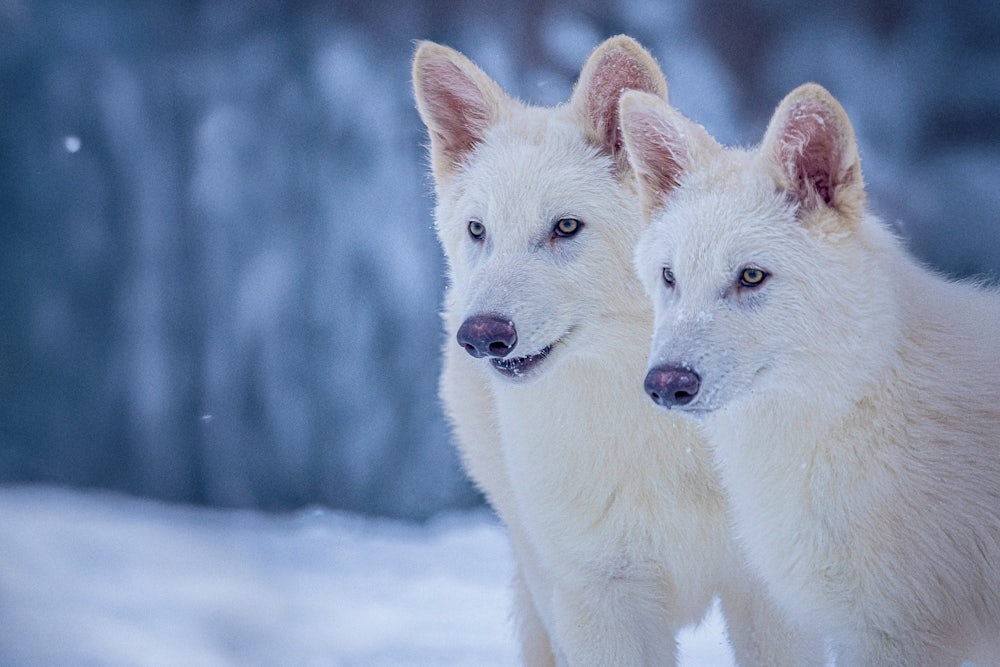Some of the media headlines have been breathless. Time magazine hailed “The Return of the Dire Wolf.” On the venerable news magazine’s cover, the word “Extinct” is crossed out. “This is Remus,” the cover declares, above the image of a large white canid. “He’s a dire wolf. The first to exist in 10,000 years. Endangered species could be changed forever.” Rolling Stone was equally credulous: “12,000 years later, Dire Wolves are back.”
No. As The Washington Post and Scientific American ably pointed out, Remus is not really a dire wolf. They aren’t “back.” Dire wolves are still extinct. A company called Colossal Biosciences, backed by Peter Thiel, among other God-cosplaying billionaires, was able to breed grey wolves with some dire wolf DNA, creating some bigger and whiter creatures. In addition to a sister, Khaleesi, there are two wolf brothers, named Romulus and Remus for the human twins who, according to mythology, were suckled by a wolf mother, in a series of unlikely events leading to the founding of Rome.
You can’t make this stuff up: As the American empire teeters on the brink of collapse, the billionaires laying waste to what’s left of our natural world and human civilization are not only trying to bring back dangerous, long-extinct animals but naming them after the mythological founders of an empire that went extinct itself due to its rulers’ arrogance. These admittedly handsome critters could easily become symbols of our own imperial collapse.
It would be hard for these animals or any descended from them to survive in the wild; the large game that dire wolves hunted isn’t as plentiful in our current world, and their old habitats are mostly gone. It’s easy to imagine that without woolly mammoths or buffalo to eat, these future hybrids could turn on us, in a Parable of the Sower scenario. Not exactly what we need right now!
But even more disturbing than the overexcitable media coverage or the dystopian possibilities are the conclusions that the current administration has drawn from this quixotic little adventure. Interior Secretary Doug Burgum, a billionaire, like many others in the Trump administration, says the appearance of these wolves shows that endangered species need “innovation, not regulation,” an echo of the trendy “abundance” discourse currently beloved by centrist Democrats. Burgum told employees in an Interior Department meeting Wednesday, “If we’re going to be in anguish about losing a species, now we have an opportunity to bring them back. Pick your favorite species, and call Colossal.” (Colossal also has plans to bring back the woolly mammoth, an even stupider idea but one that Elon Musk is excited about.)
Burgum’s position is dangerously deranged. Nature itself is “innovating” all the time, but the most important way that humans can save endangered species is by regulating our own activities to protect them and their habitats. The latter is the only known way that species like the Florida panthers have returned from near-extinction, and keeps many other species from getting there. As The Washington Post implied in an article Thursday, the administration is using this weird science experiment to justify its own plans to decimate endangered species protections that have been in place since the Nixon administration.
Even before Trump and his band of anti-environmental bandits announced these plans, scientists had flagged more than a million species for risk of extinction in the coming decades. The changes that Burgum is currently making will imperil spotted owls, sea turtles, and many more.
Why, in this context, do our oligarchs eschew protections for the animals we already love—like whales and manatees—preferring to bring back some rejiggered hapless version of the ancient dire wolf, which no current ecosystem needs? Precisely for the reason Burgum admits: They don’t want regulation. They claim that’s because regulation has “failed,” but that’s nonsense: The Endangered Species Act has saved the vast majority of listed species from extinction, including the gray whale, the peregrine falcon, the grizzly bear, and the bald eagle, our national bird. Oligarchs prefer Colossal’s entirely untested and wildly inefficient approach because its supposed “innovation” puts them at the center, and because, even better, shredding regulation allows them to continue trashing the world unhindered, destroying anything that stands in the way of their profits.
Speaking of current species that need the regulatory system that Bergum is trying so hard to eviscerate, we still have real live wolves. It’s particularly rich that these so-called dire wolves are essentially gray wolves with a little bit of gene editing, because the gray wolf, a magnificent animal that cannot be improved by oligarchic interference, is particularly besieged by human policies. That wolf has been protected by the Endangered Species Act since 1974, when it was hunted nearly to extinction. Since then, the species has rebounded in many Western states, but Trump removed protections for gray wolves in 2020, and Idaho and Montana are deliberately seeking to reduce their numbers, killing them recklessly. Republican billionaires and far-right politicians may applaud the engineering of this strange lab-grown model, but the world they’re creating is utterly inhospitable to the real wolf.
The only way this “dire wolf” project could be helpful to the cause of animal conservation is if Romulus, Remus, and Khaleesi grow up with a special appetite for oligarchs. That, I must admit, would be an outcome worthy of significant research investment. But it’s likely not what Peter Thiel has in mind.








